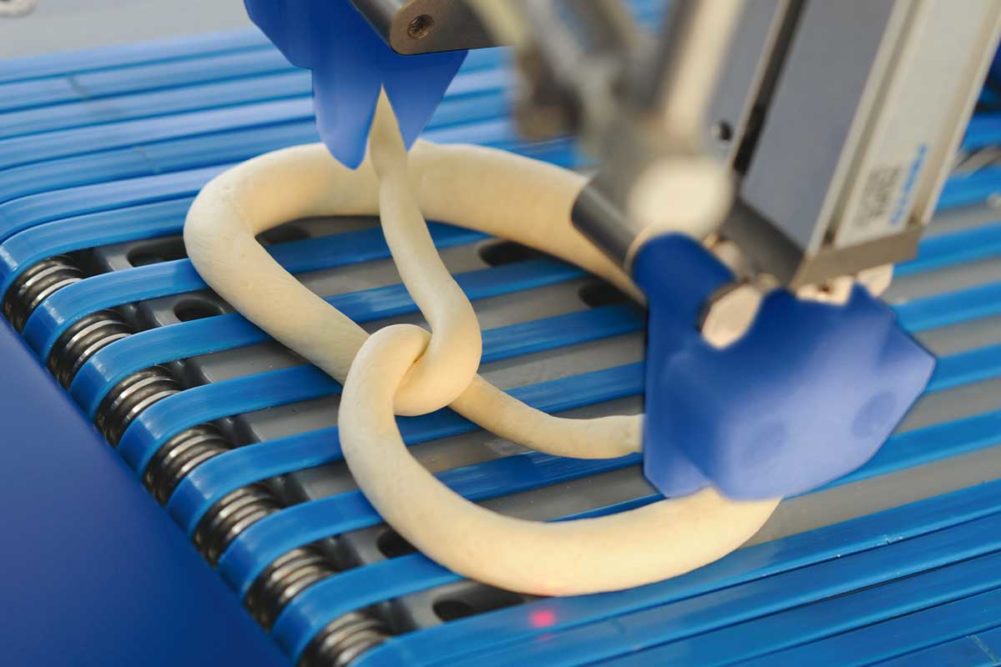Although most pretzel processing equipment will have the capacity to handle gluten-free pretzel production, special considerations and adjustments to equipment may be needed when processing these dry, sticky doughs.
For instance, Nico Roesler, North American pretzel and snack equipment sales manager for Reading Bakery Systems, explained the benefits of using a low-pressure extruder.
“Because gluten-free doughs do not have the strength and elasticity that wheat-based doughs have, they must be fed into the low-pressure extruder using prefeed rolls,” he said. “These rolls sit on top of the low-pressure extruders’ two augers, and they are able to grip and force the gluten-free dough down into the extruder’s barrel. Without prefeed rolls, the dough would bridge and not form consistent pressure inside the extruder, which would lead to a wide range of problems including inconsistent piece weights.”
Prefeed rolls can easily be added to existing equipment, Mr. Roesler said. The rolls add 7 inches to the stack of the system, which may require an adjustment to the dough handling system to feed the hoppers that sit a bit higher.
Some of the greatest challenges of processing gluten-free doughs stem from the lack of strength and elasticity compared with wheat-based formulations.
“When trying to coextrude using these types of doughs, a lot of consideration needs to be put on the strength of the dough and how well it can incapsulate a filling,” Mr. Roesler said. “The gluten-free pretzel shell must be strong enough to be crimped with a guillotine cutter and hold in the inclusion, whether that be peanut butter, almond butter or any other filling. Often, gluten-free doughs do not have that strength and can open in the cooking or baking process, which leads to filling leaking out in the oven, which creates a fire hazard and a big mess.”
Certain shapes like pretzel flats can also create challenges.
“These shapes have a lot of surface area and must have enough strength to withstand the caustic cooker bath without dissolving,” he said. “They must also be able to handle belt transfers without losing shape or being pulled apart. Other shapes like thicker pretzel rods, nuggets or sticks might also require ultrasonic cutting.”
Big pretzels can also be tricky.
“Large traditional pretzels are the hardest to handle because of the long dough piece. Twisting and moving them and keeping shape is difficult,” said Bruce Gingrich, vice president of sales, WP Bakery Group USA. “Automation for these items is also more complex.”
One Fritsch Multitwist can produce 2,000 pretzels an hour, although up to 10 modules can be set up in parallel to increase output to 20,000 pretzels an hour. It can also produce many twisted products such as plaits, knots, rings, sticks, loops and flatbread, and can handle weights from 1.4-oz to 10-oz pretzels, enabling pretzel manufacturers to produce a wide variety of products.
Spooner Vicars provides laminated lines for pretzels, although sheeted lines are more common. All of the equipment has the capacity to handle gluten-free doughs, depending on the formulation.
“Spooner Vicars’ forming equipment includes as standard appropriate device adjustments to ensure the dough sheet/cut pieces are efficiently handled in keeping with the difficult nature of the dough,” said Andy Green, technical development manager at the company. “This includes independently driven top and bottom gauge rollers, radially adjustable roller scrapers and variable position transfer points.”
He added that nonstick coatings can be applied to the surface of the gauge rollers and roller scrapers to reduce stripping and improve dough sheet transfer.
“It is also critical to ensure the drive cascade system is fine-tuned to ensure when master speed references are changed, the speed ratios of all the drives affected remain the same, without having a detrimental effect on the dough sheet, by either stretching or crushing by under- or over-feeding,” Mr. Green said.
After forming and proofing, the pretzels go through a cooker bath with an alkaline solution, which controls pretzels’ color and flavor. The cooker holds a dipping bath that normally consists of sodium hydroxide and water heated to between 88°F and 98°F. Pretzels typically are submerged for less than 15 seconds.
Lipika Mandal, food technologist, Spooner Vicars Bakery Systems, a Middleby Bakery company, advised running gluten-free products on separate equipment to avoid cross-contamination and possible harm to consumers with celiac disease.
Mr. Roesler echoed that sentiment, explaining that a changeover from a wheat-based pretzel to gluten-free is tough. Most equipment is dry cleaned, and removing gluten allergens from an extruder, mixer or dry ingredient handling is time-consuming and labor-intensive.
Processing gluten-free pretzel doughs can be conquered and often doesn’t require new, more powerful equipment. It just takes precise formulations and using the right equipment to manage the challenges posed by these dense, dry and sticky doughs.
This article is an excerpt from the October 2022 issue of Baking & Snack. To read the entire feature on Pretzel Processing, click here.






